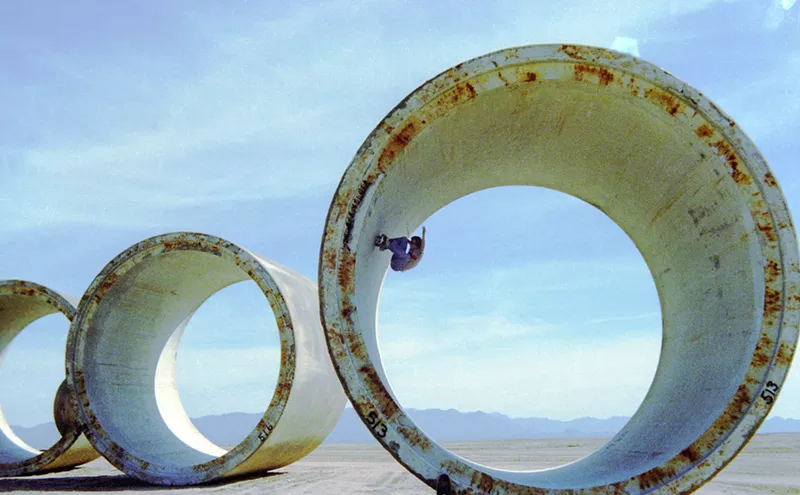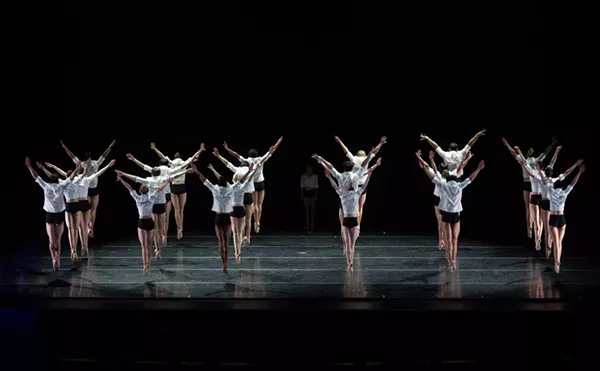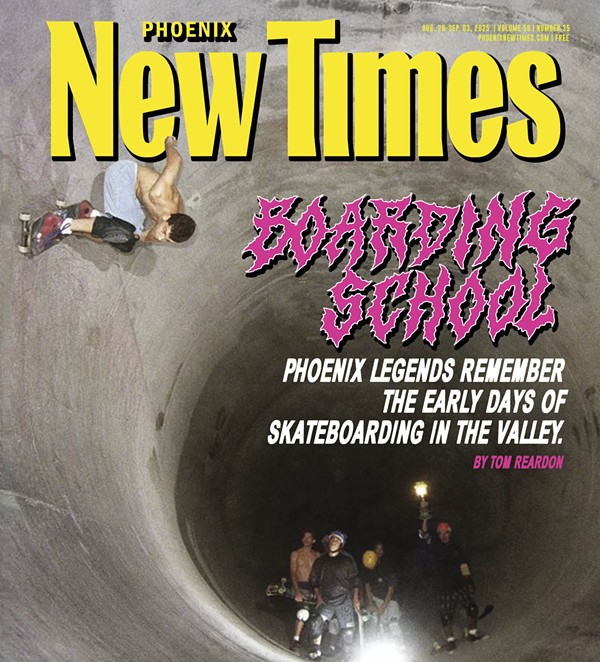I was wrong. While Theater Works' overly ambitious production of She Loves Me was no surprise, the other two companies upset my expectations. PT's production of West Side Story proved to be polished and entertaining, while the Planet Earth show was merely an obnoxious, barely lucid mess that resembled that company's worst failures.
Phoenix Theatre's success with West Side Story is especially impressive. Without a million-dollar budget and an exceptional cast, Arthur Laurents' 1957 update of Romeo and Juliet is tough to pull off. Audience expectations are high; they know this show better than any other contemporary musical, thanks to its long Broadway run, its successive road companies, and its Oscar-winning film version. Nearly every song in the Leonard Bernstein/Stephen Sondheim score has become a standard, and Jerome Robbins' landmark choreography (credited with completing the integration of dance into the American musical by fusing principal singers and dancers into a single chorus) is still referenced today.
Casting is the main obstacle in staging a successful West Side Story. Every one of its principals is called on to sing, dance and act; its chorus must execute modern, jazz, and ethnic dance movements as well as tackle structurally complex musical numbers. Phoenix Theatre has risen to the challenge, abandoning its usual cliquish casting principles and corralling some of the best local talent both on and behind center stage.
Director Michael Mitchell, whose lapses in judgment have skewered past PT productions, had his hands full here. He assigned the lead roles to a pair of largely unknown young actors, and took on an amateur cast of teenaged Sharks and Jets borrowed from the theater program at South Mountain High School. With this show, Mitchell has proven once and for all that, when he forgets about hiring his friends and pleasing his largely blue-haired subscriber base, he can bring off a fine evening's entertainment. His West Side Story is more an homage to the original than a copy of it, and he's wisely sidestepped the temptation to make topical this story of gang warfare between white and Puerto Rican teenage gangs.
Mitchell has recruited some expert help. He's brought in James Zager, who trained with Robbins colleague James Moore, to adapt the late dance master's groundbreaking choreography. Zager has grafted many of Robbins's trademark steps onto a simpler, more natural dance vocabulary, modifying many moves to fit the talents of his untrained young chorus. Jeff Thomson's mobile set design, moodily lighted by Paul Black, integrates the brightly painted chain link of Hell's Kitchen into scenes set in a dress shop, a drugstore, and a teenaged girl's bedroom. And Jerry Wayne Harkey's lush 14-piece orchestra performs beautifully Bernstein's well-loved symphonic suites.
This is not a faultless production. It's occasionally obvious that Robbins' stylized dances have been trimmed to accommodate the cast's dancing talents, and the limitations of the show's young leads are also sometimes apparent. As Tony, angel-voiced Bryan Slade is awkward in emotional scenes, and Jeanine Pacheco's fresh-faced Maria is wonderfully acted though hardly fleet-footed. But I'm not forgetting that the original Tony and Maria, Carol Lawrence and Larry Kert, were primarily dancers hired for their hoofing abilities and trained to sing for this show, or that Natalie Wood's vocals were dubbed by Marnie Nixon for the movie version. I liked Slade and Pacheco's solos just fine, and the wonderful blend of their voices when they sang together made up for their inconsistencies elsewhere.
In a supporting cast that features several local favorites, Michelle Gardner's performance as Anita is a standout. Anita is the musical's showiest role, and also the most difficult to sell: She must display high comedy (while deftly dancing and singing "America"), fear (the scene where she's nearly raped by the Jets), sex (her monologue about her husband's prowess after a rumble) and sorrow (her duet with Maria, "A Boy Like That/I Have a Love"). Gardner knocks each off with equal aplomb, and her numbers are the highlight of an overall exceptional production.
I had high hopes for Blackball Ensemble, the newest group to attempt a take-over of Planet Earth Multi-Cultural Theater, after one of its players assured me that he and his colleagues planned to take the company "in a new direction." But if its current production, David Greenspan's horrid Dead Mother or Shirley Not All in Vain, is any indication, this troupe is only up to the same wiener-wagging twaddle as its predecessors.
This pseudo-intellectual, absurdist comedy amounts to little more than two pain-wracked hours of low-camp shock theater. Greenspan's numbingly non-linear story, which lapses often into inept homages to Greek mythology and French literature, concerns a pair of conniving brothers, one of whom impersonates his dead mother in an attempt to please the other's fiancA, who demands to meet her intended's family before she'll marry him. The author's pastiche of anti-gay, anti-Semitic horse hockey was met with cold stares the night I saw it; one wise soul snuck out after the first half hour. (I knew we were in for a long evening when, in the first five minutes, one character began droning a tone poem about having sex with her brother-in-law.)
The real horror is that Dead Mother's cast, a fledgling company of former ASU students who've performed admirably on that school's stages, is wasting its time and talent on this kind of nonsense. I'm hoping that someone will step in and inform these capable kids that wearing plastic phalluses and simulating sex with inflatable sheep is neither shocking nor entertaining; it's just dumb.
I'm frankly surprised that PT's West Side Story didn't tank, and that the talents of ASU's theater alumnae haven't, as yet, breathed life into Planet Earth's perishing playhouse. I'm even more startled to find myself writing a recommendation for skipping a new, unusual piece of theater in favor of the umpteenth production of a classic stage musical. Consider it done.
West Side Story continues through October 11 at Phoenix Theatre, 100 East McDowell.
Dead Mother or Shirley Not All in Vain continues through October 3 at Planet Earth Multi-Cultural Theater, 909 North Third Street.










